Mr. Smith’s Case Study
VerifiedAdded on 2023/01/17
|7
|3062
|89
AI Summary
This case study focuses on Mr. Smith, a 70-year-old male with congestive heart failure. It discusses his medical history, nursing priorities, interventions, and discharge planning. The essay provides insights into managing his breathing pattern and cardiovascular function.
Contribute Materials
Your contribution can guide someone’s learning journey. Share your
documents today.
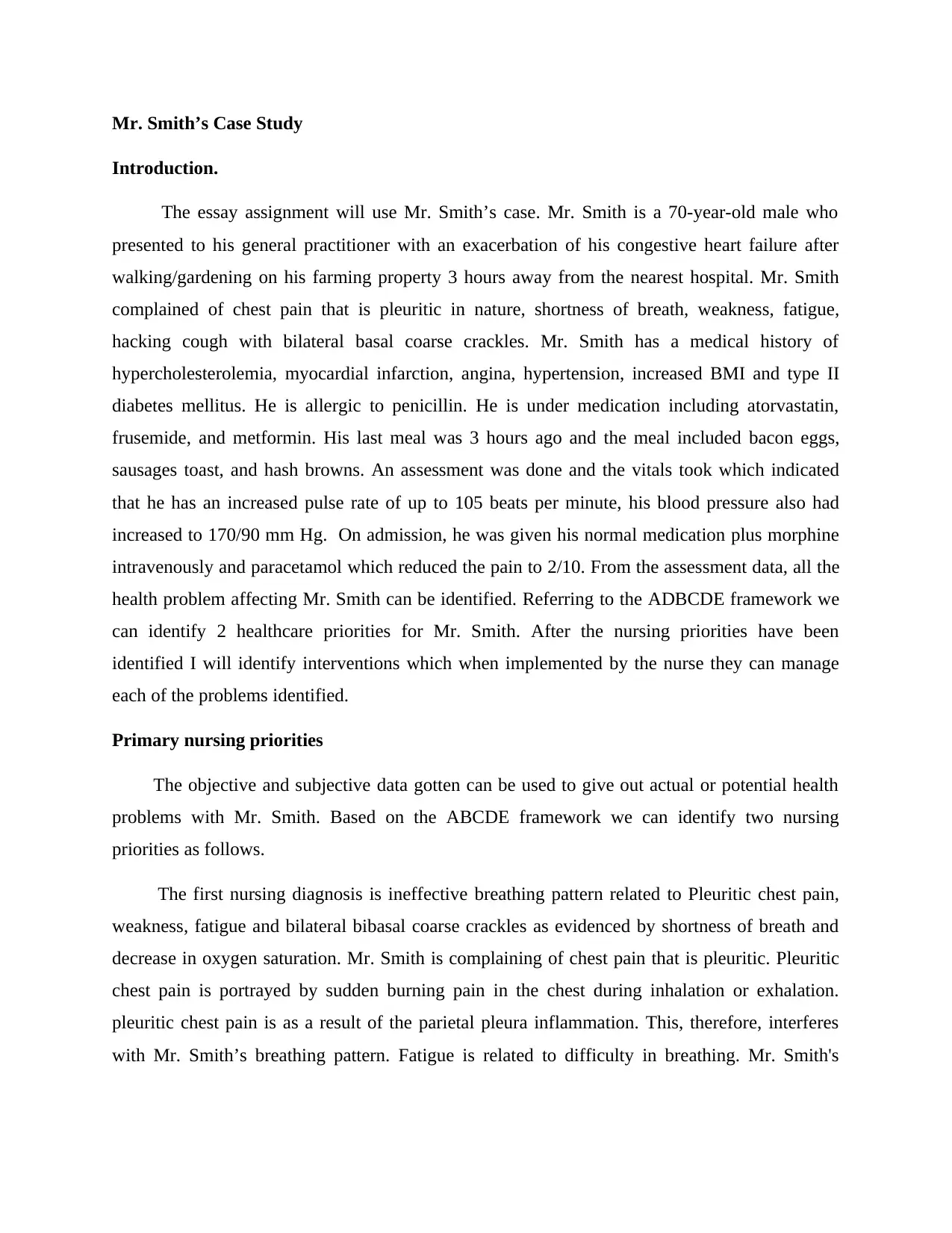
Mr. Smith’s Case Study
Introduction.
The essay assignment will use Mr. Smith’s case. Mr. Smith is a 70-year-old male who
presented to his general practitioner with an exacerbation of his congestive heart failure after
walking/gardening on his farming property 3 hours away from the nearest hospital. Mr. Smith
complained of chest pain that is pleuritic in nature, shortness of breath, weakness, fatigue,
hacking cough with bilateral basal coarse crackles. Mr. Smith has a medical history of
hypercholesterolemia, myocardial infarction, angina, hypertension, increased BMI and type II
diabetes mellitus. He is allergic to penicillin. He is under medication including atorvastatin,
frusemide, and metformin. His last meal was 3 hours ago and the meal included bacon eggs,
sausages toast, and hash browns. An assessment was done and the vitals took which indicated
that he has an increased pulse rate of up to 105 beats per minute, his blood pressure also had
increased to 170/90 mm Hg. On admission, he was given his normal medication plus morphine
intravenously and paracetamol which reduced the pain to 2/10. From the assessment data, all the
health problem affecting Mr. Smith can be identified. Referring to the ADBCDE framework we
can identify 2 healthcare priorities for Mr. Smith. After the nursing priorities have been
identified I will identify interventions which when implemented by the nurse they can manage
each of the problems identified.
Primary nursing priorities
The objective and subjective data gotten can be used to give out actual or potential health
problems with Mr. Smith. Based on the ABCDE framework we can identify two nursing
priorities as follows.
The first nursing diagnosis is ineffective breathing pattern related to Pleuritic chest pain,
weakness, fatigue and bilateral bibasal coarse crackles as evidenced by shortness of breath and
decrease in oxygen saturation. Mr. Smith is complaining of chest pain that is pleuritic. Pleuritic
chest pain is portrayed by sudden burning pain in the chest during inhalation or exhalation.
pleuritic chest pain is as a result of the parietal pleura inflammation. This, therefore, interferes
with Mr. Smith’s breathing pattern. Fatigue is related to difficulty in breathing. Mr. Smith's
Introduction.
The essay assignment will use Mr. Smith’s case. Mr. Smith is a 70-year-old male who
presented to his general practitioner with an exacerbation of his congestive heart failure after
walking/gardening on his farming property 3 hours away from the nearest hospital. Mr. Smith
complained of chest pain that is pleuritic in nature, shortness of breath, weakness, fatigue,
hacking cough with bilateral basal coarse crackles. Mr. Smith has a medical history of
hypercholesterolemia, myocardial infarction, angina, hypertension, increased BMI and type II
diabetes mellitus. He is allergic to penicillin. He is under medication including atorvastatin,
frusemide, and metformin. His last meal was 3 hours ago and the meal included bacon eggs,
sausages toast, and hash browns. An assessment was done and the vitals took which indicated
that he has an increased pulse rate of up to 105 beats per minute, his blood pressure also had
increased to 170/90 mm Hg. On admission, he was given his normal medication plus morphine
intravenously and paracetamol which reduced the pain to 2/10. From the assessment data, all the
health problem affecting Mr. Smith can be identified. Referring to the ADBCDE framework we
can identify 2 healthcare priorities for Mr. Smith. After the nursing priorities have been
identified I will identify interventions which when implemented by the nurse they can manage
each of the problems identified.
Primary nursing priorities
The objective and subjective data gotten can be used to give out actual or potential health
problems with Mr. Smith. Based on the ABCDE framework we can identify two nursing
priorities as follows.
The first nursing diagnosis is ineffective breathing pattern related to Pleuritic chest pain,
weakness, fatigue and bilateral bibasal coarse crackles as evidenced by shortness of breath and
decrease in oxygen saturation. Mr. Smith is complaining of chest pain that is pleuritic. Pleuritic
chest pain is portrayed by sudden burning pain in the chest during inhalation or exhalation.
pleuritic chest pain is as a result of the parietal pleura inflammation. This, therefore, interferes
with Mr. Smith’s breathing pattern. Fatigue is related to difficulty in breathing. Mr. Smith's
Secure Best Marks with AI Grader
Need help grading? Try our AI Grader for instant feedback on your assignments.
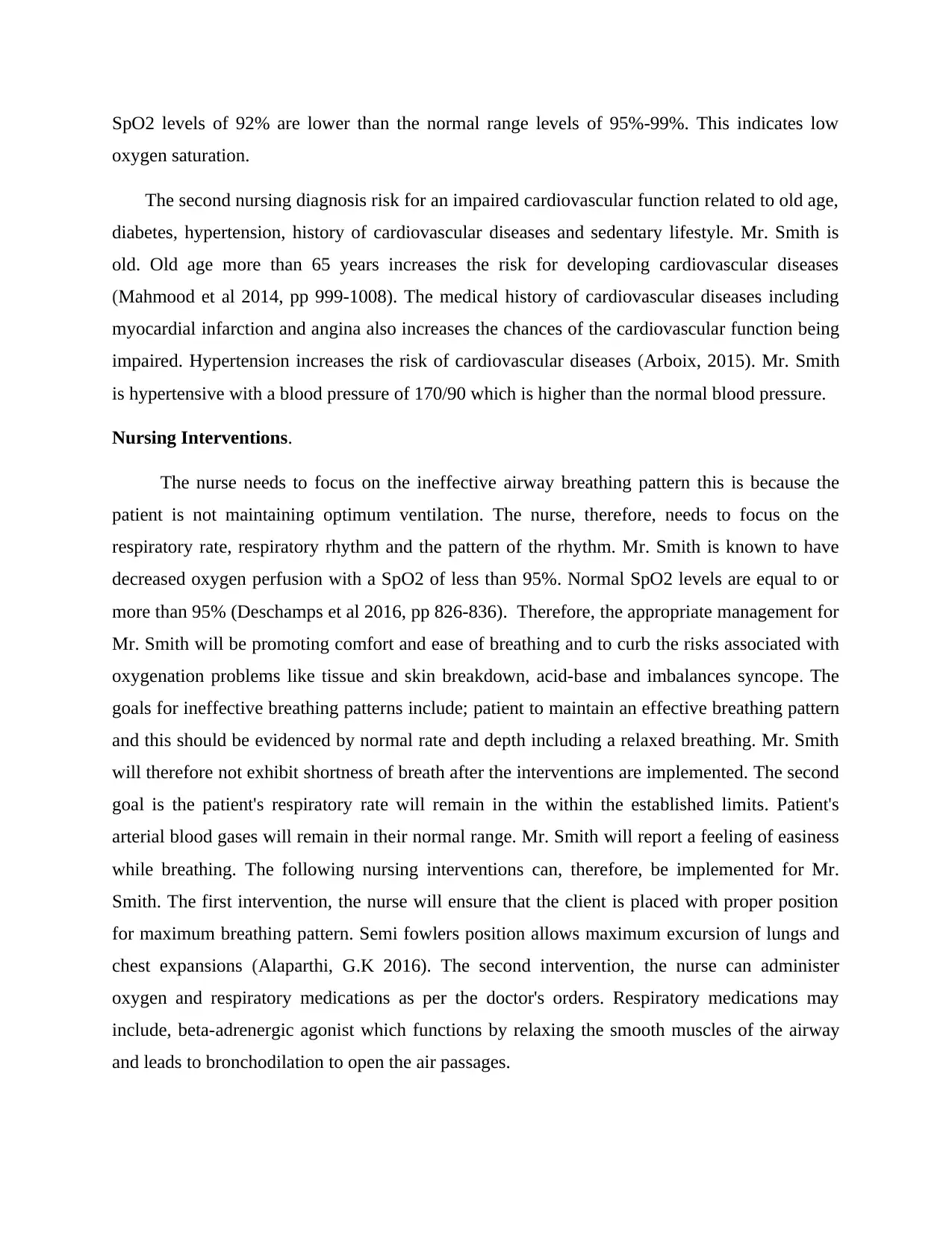
SpO2 levels of 92% are lower than the normal range levels of 95%-99%. This indicates low
oxygen saturation.
The second nursing diagnosis risk for an impaired cardiovascular function related to old age,
diabetes, hypertension, history of cardiovascular diseases and sedentary lifestyle. Mr. Smith is
old. Old age more than 65 years increases the risk for developing cardiovascular diseases
(Mahmood et al 2014, pp 999-1008). The medical history of cardiovascular diseases including
myocardial infarction and angina also increases the chances of the cardiovascular function being
impaired. Hypertension increases the risk of cardiovascular diseases (Arboix, 2015). Mr. Smith
is hypertensive with a blood pressure of 170/90 which is higher than the normal blood pressure.
Nursing Interventions.
The nurse needs to focus on the ineffective airway breathing pattern this is because the
patient is not maintaining optimum ventilation. The nurse, therefore, needs to focus on the
respiratory rate, respiratory rhythm and the pattern of the rhythm. Mr. Smith is known to have
decreased oxygen perfusion with a SpO2 of less than 95%. Normal SpO2 levels are equal to or
more than 95% (Deschamps et al 2016, pp 826-836). Therefore, the appropriate management for
Mr. Smith will be promoting comfort and ease of breathing and to curb the risks associated with
oxygenation problems like tissue and skin breakdown, acid-base and imbalances syncope. The
goals for ineffective breathing patterns include; patient to maintain an effective breathing pattern
and this should be evidenced by normal rate and depth including a relaxed breathing. Mr. Smith
will therefore not exhibit shortness of breath after the interventions are implemented. The second
goal is the patient's respiratory rate will remain in the within the established limits. Patient's
arterial blood gases will remain in their normal range. Mr. Smith will report a feeling of easiness
while breathing. The following nursing interventions can, therefore, be implemented for Mr.
Smith. The first intervention, the nurse will ensure that the client is placed with proper position
for maximum breathing pattern. Semi fowlers position allows maximum excursion of lungs and
chest expansions (Alaparthi, G.K 2016). The second intervention, the nurse can administer
oxygen and respiratory medications as per the doctor's orders. Respiratory medications may
include, beta-adrenergic agonist which functions by relaxing the smooth muscles of the airway
and leads to bronchodilation to open the air passages.
oxygen saturation.
The second nursing diagnosis risk for an impaired cardiovascular function related to old age,
diabetes, hypertension, history of cardiovascular diseases and sedentary lifestyle. Mr. Smith is
old. Old age more than 65 years increases the risk for developing cardiovascular diseases
(Mahmood et al 2014, pp 999-1008). The medical history of cardiovascular diseases including
myocardial infarction and angina also increases the chances of the cardiovascular function being
impaired. Hypertension increases the risk of cardiovascular diseases (Arboix, 2015). Mr. Smith
is hypertensive with a blood pressure of 170/90 which is higher than the normal blood pressure.
Nursing Interventions.
The nurse needs to focus on the ineffective airway breathing pattern this is because the
patient is not maintaining optimum ventilation. The nurse, therefore, needs to focus on the
respiratory rate, respiratory rhythm and the pattern of the rhythm. Mr. Smith is known to have
decreased oxygen perfusion with a SpO2 of less than 95%. Normal SpO2 levels are equal to or
more than 95% (Deschamps et al 2016, pp 826-836). Therefore, the appropriate management for
Mr. Smith will be promoting comfort and ease of breathing and to curb the risks associated with
oxygenation problems like tissue and skin breakdown, acid-base and imbalances syncope. The
goals for ineffective breathing patterns include; patient to maintain an effective breathing pattern
and this should be evidenced by normal rate and depth including a relaxed breathing. Mr. Smith
will therefore not exhibit shortness of breath after the interventions are implemented. The second
goal is the patient's respiratory rate will remain in the within the established limits. Patient's
arterial blood gases will remain in their normal range. Mr. Smith will report a feeling of easiness
while breathing. The following nursing interventions can, therefore, be implemented for Mr.
Smith. The first intervention, the nurse will ensure that the client is placed with proper position
for maximum breathing pattern. Semi fowlers position allows maximum excursion of lungs and
chest expansions (Alaparthi, G.K 2016). The second intervention, the nurse can administer
oxygen and respiratory medications as per the doctor's orders. Respiratory medications may
include, beta-adrenergic agonist which functions by relaxing the smooth muscles of the airway
and leads to bronchodilation to open the air passages.
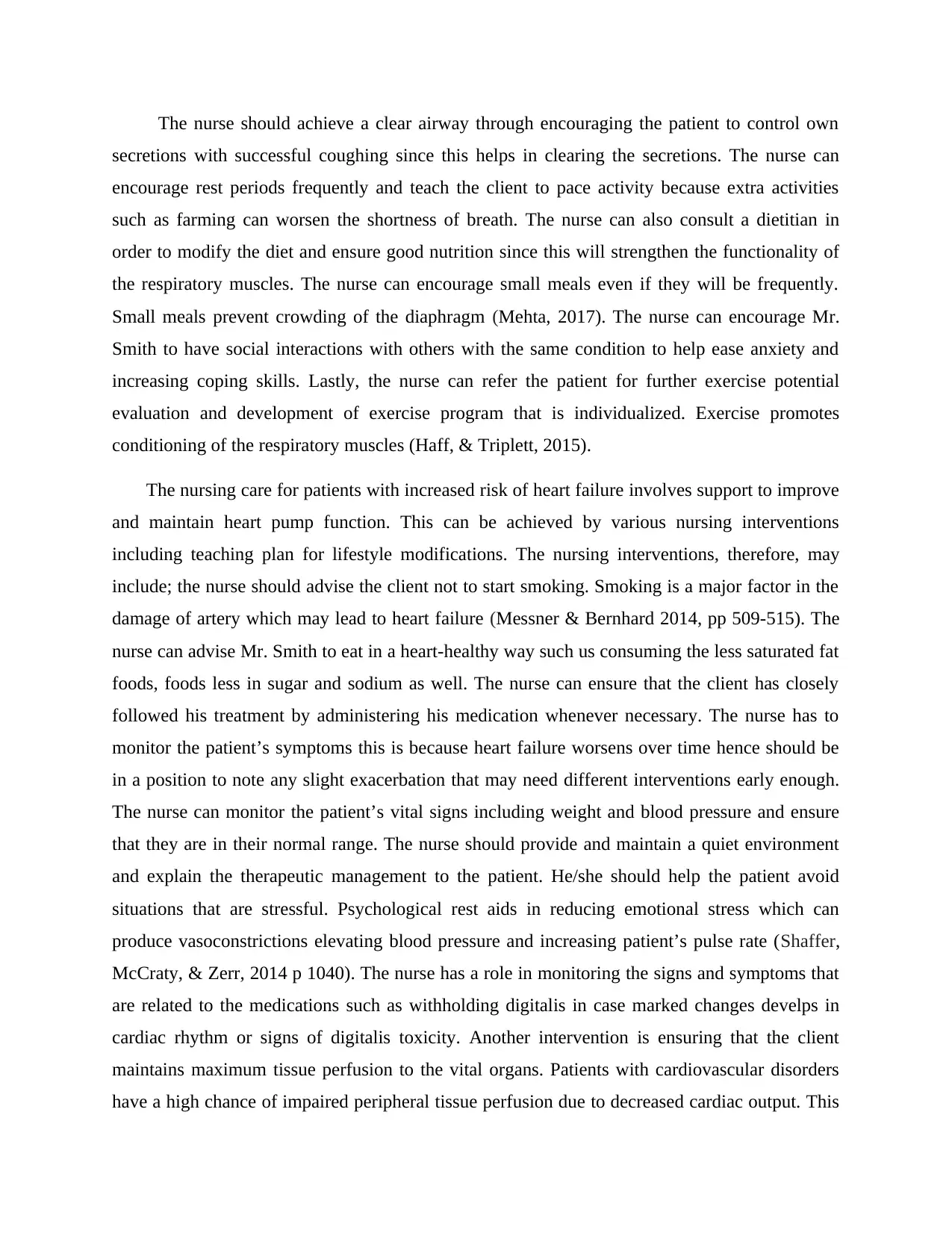
The nurse should achieve a clear airway through encouraging the patient to control own
secretions with successful coughing since this helps in clearing the secretions. The nurse can
encourage rest periods frequently and teach the client to pace activity because extra activities
such as farming can worsen the shortness of breath. The nurse can also consult a dietitian in
order to modify the diet and ensure good nutrition since this will strengthen the functionality of
the respiratory muscles. The nurse can encourage small meals even if they will be frequently.
Small meals prevent crowding of the diaphragm (Mehta, 2017). The nurse can encourage Mr.
Smith to have social interactions with others with the same condition to help ease anxiety and
increasing coping skills. Lastly, the nurse can refer the patient for further exercise potential
evaluation and development of exercise program that is individualized. Exercise promotes
conditioning of the respiratory muscles (Haff, & Triplett, 2015).
The nursing care for patients with increased risk of heart failure involves support to improve
and maintain heart pump function. This can be achieved by various nursing interventions
including teaching plan for lifestyle modifications. The nursing interventions, therefore, may
include; the nurse should advise the client not to start smoking. Smoking is a major factor in the
damage of artery which may lead to heart failure (Messner & Bernhard 2014, pp 509-515). The
nurse can advise Mr. Smith to eat in a heart-healthy way such us consuming the less saturated fat
foods, foods less in sugar and sodium as well. The nurse can ensure that the client has closely
followed his treatment by administering his medication whenever necessary. The nurse has to
monitor the patient’s symptoms this is because heart failure worsens over time hence should be
in a position to note any slight exacerbation that may need different interventions early enough.
The nurse can monitor the patient’s vital signs including weight and blood pressure and ensure
that they are in their normal range. The nurse should provide and maintain a quiet environment
and explain the therapeutic management to the patient. He/she should help the patient avoid
situations that are stressful. Psychological rest aids in reducing emotional stress which can
produce vasoconstrictions elevating blood pressure and increasing patient’s pulse rate (Shaffer,
McCraty, & Zerr, 2014 p 1040). The nurse has a role in monitoring the signs and symptoms that
are related to the medications such as withholding digitalis in case marked changes develps in
cardiac rhythm or signs of digitalis toxicity. Another intervention is ensuring that the client
maintains maximum tissue perfusion to the vital organs. Patients with cardiovascular disorders
have a high chance of impaired peripheral tissue perfusion due to decreased cardiac output. This
secretions with successful coughing since this helps in clearing the secretions. The nurse can
encourage rest periods frequently and teach the client to pace activity because extra activities
such as farming can worsen the shortness of breath. The nurse can also consult a dietitian in
order to modify the diet and ensure good nutrition since this will strengthen the functionality of
the respiratory muscles. The nurse can encourage small meals even if they will be frequently.
Small meals prevent crowding of the diaphragm (Mehta, 2017). The nurse can encourage Mr.
Smith to have social interactions with others with the same condition to help ease anxiety and
increasing coping skills. Lastly, the nurse can refer the patient for further exercise potential
evaluation and development of exercise program that is individualized. Exercise promotes
conditioning of the respiratory muscles (Haff, & Triplett, 2015).
The nursing care for patients with increased risk of heart failure involves support to improve
and maintain heart pump function. This can be achieved by various nursing interventions
including teaching plan for lifestyle modifications. The nursing interventions, therefore, may
include; the nurse should advise the client not to start smoking. Smoking is a major factor in the
damage of artery which may lead to heart failure (Messner & Bernhard 2014, pp 509-515). The
nurse can advise Mr. Smith to eat in a heart-healthy way such us consuming the less saturated fat
foods, foods less in sugar and sodium as well. The nurse can ensure that the client has closely
followed his treatment by administering his medication whenever necessary. The nurse has to
monitor the patient’s symptoms this is because heart failure worsens over time hence should be
in a position to note any slight exacerbation that may need different interventions early enough.
The nurse can monitor the patient’s vital signs including weight and blood pressure and ensure
that they are in their normal range. The nurse should provide and maintain a quiet environment
and explain the therapeutic management to the patient. He/she should help the patient avoid
situations that are stressful. Psychological rest aids in reducing emotional stress which can
produce vasoconstrictions elevating blood pressure and increasing patient’s pulse rate (Shaffer,
McCraty, & Zerr, 2014 p 1040). The nurse has a role in monitoring the signs and symptoms that
are related to the medications such as withholding digitalis in case marked changes develps in
cardiac rhythm or signs of digitalis toxicity. Another intervention is ensuring that the client
maintains maximum tissue perfusion to the vital organs. Patients with cardiovascular disorders
have a high chance of impaired peripheral tissue perfusion due to decreased cardiac output. This
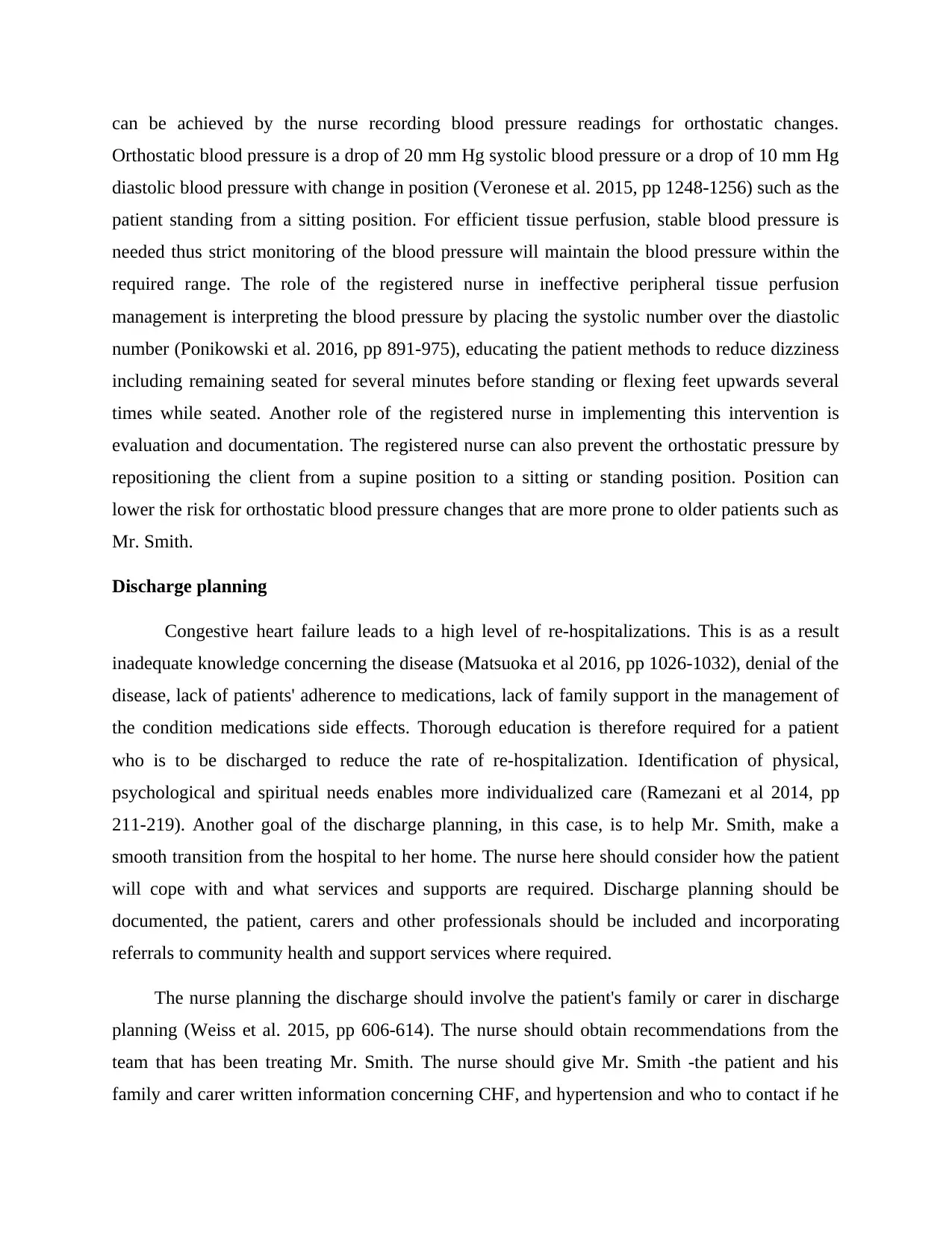
can be achieved by the nurse recording blood pressure readings for orthostatic changes.
Orthostatic blood pressure is a drop of 20 mm Hg systolic blood pressure or a drop of 10 mm Hg
diastolic blood pressure with change in position (Veronese et al. 2015, pp 1248-1256) such as the
patient standing from a sitting position. For efficient tissue perfusion, stable blood pressure is
needed thus strict monitoring of the blood pressure will maintain the blood pressure within the
required range. The role of the registered nurse in ineffective peripheral tissue perfusion
management is interpreting the blood pressure by placing the systolic number over the diastolic
number (Ponikowski et al. 2016, pp 891-975), educating the patient methods to reduce dizziness
including remaining seated for several minutes before standing or flexing feet upwards several
times while seated. Another role of the registered nurse in implementing this intervention is
evaluation and documentation. The registered nurse can also prevent the orthostatic pressure by
repositioning the client from a supine position to a sitting or standing position. Position can
lower the risk for orthostatic blood pressure changes that are more prone to older patients such as
Mr. Smith.
Discharge planning
Congestive heart failure leads to a high level of re-hospitalizations. This is as a result
inadequate knowledge concerning the disease (Matsuoka et al 2016, pp 1026-1032), denial of the
disease, lack of patients' adherence to medications, lack of family support in the management of
the condition medications side effects. Thorough education is therefore required for a patient
who is to be discharged to reduce the rate of re-hospitalization. Identification of physical,
psychological and spiritual needs enables more individualized care (Ramezani et al 2014, pp
211-219). Another goal of the discharge planning, in this case, is to help Mr. Smith, make a
smooth transition from the hospital to her home. The nurse here should consider how the patient
will cope with and what services and supports are required. Discharge planning should be
documented, the patient, carers and other professionals should be included and incorporating
referrals to community health and support services where required.
The nurse planning the discharge should involve the patient's family or carer in discharge
planning (Weiss et al. 2015, pp 606-614). The nurse should obtain recommendations from the
team that has been treating Mr. Smith. The nurse should give Mr. Smith -the patient and his
family and carer written information concerning CHF, and hypertension and who to contact if he
Orthostatic blood pressure is a drop of 20 mm Hg systolic blood pressure or a drop of 10 mm Hg
diastolic blood pressure with change in position (Veronese et al. 2015, pp 1248-1256) such as the
patient standing from a sitting position. For efficient tissue perfusion, stable blood pressure is
needed thus strict monitoring of the blood pressure will maintain the blood pressure within the
required range. The role of the registered nurse in ineffective peripheral tissue perfusion
management is interpreting the blood pressure by placing the systolic number over the diastolic
number (Ponikowski et al. 2016, pp 891-975), educating the patient methods to reduce dizziness
including remaining seated for several minutes before standing or flexing feet upwards several
times while seated. Another role of the registered nurse in implementing this intervention is
evaluation and documentation. The registered nurse can also prevent the orthostatic pressure by
repositioning the client from a supine position to a sitting or standing position. Position can
lower the risk for orthostatic blood pressure changes that are more prone to older patients such as
Mr. Smith.
Discharge planning
Congestive heart failure leads to a high level of re-hospitalizations. This is as a result
inadequate knowledge concerning the disease (Matsuoka et al 2016, pp 1026-1032), denial of the
disease, lack of patients' adherence to medications, lack of family support in the management of
the condition medications side effects. Thorough education is therefore required for a patient
who is to be discharged to reduce the rate of re-hospitalization. Identification of physical,
psychological and spiritual needs enables more individualized care (Ramezani et al 2014, pp
211-219). Another goal of the discharge planning, in this case, is to help Mr. Smith, make a
smooth transition from the hospital to her home. The nurse here should consider how the patient
will cope with and what services and supports are required. Discharge planning should be
documented, the patient, carers and other professionals should be included and incorporating
referrals to community health and support services where required.
The nurse planning the discharge should involve the patient's family or carer in discharge
planning (Weiss et al. 2015, pp 606-614). The nurse should obtain recommendations from the
team that has been treating Mr. Smith. The nurse should give Mr. Smith -the patient and his
family and carer written information concerning CHF, and hypertension and who to contact if he
Secure Best Marks with AI Grader
Need help grading? Try our AI Grader for instant feedback on your assignments.
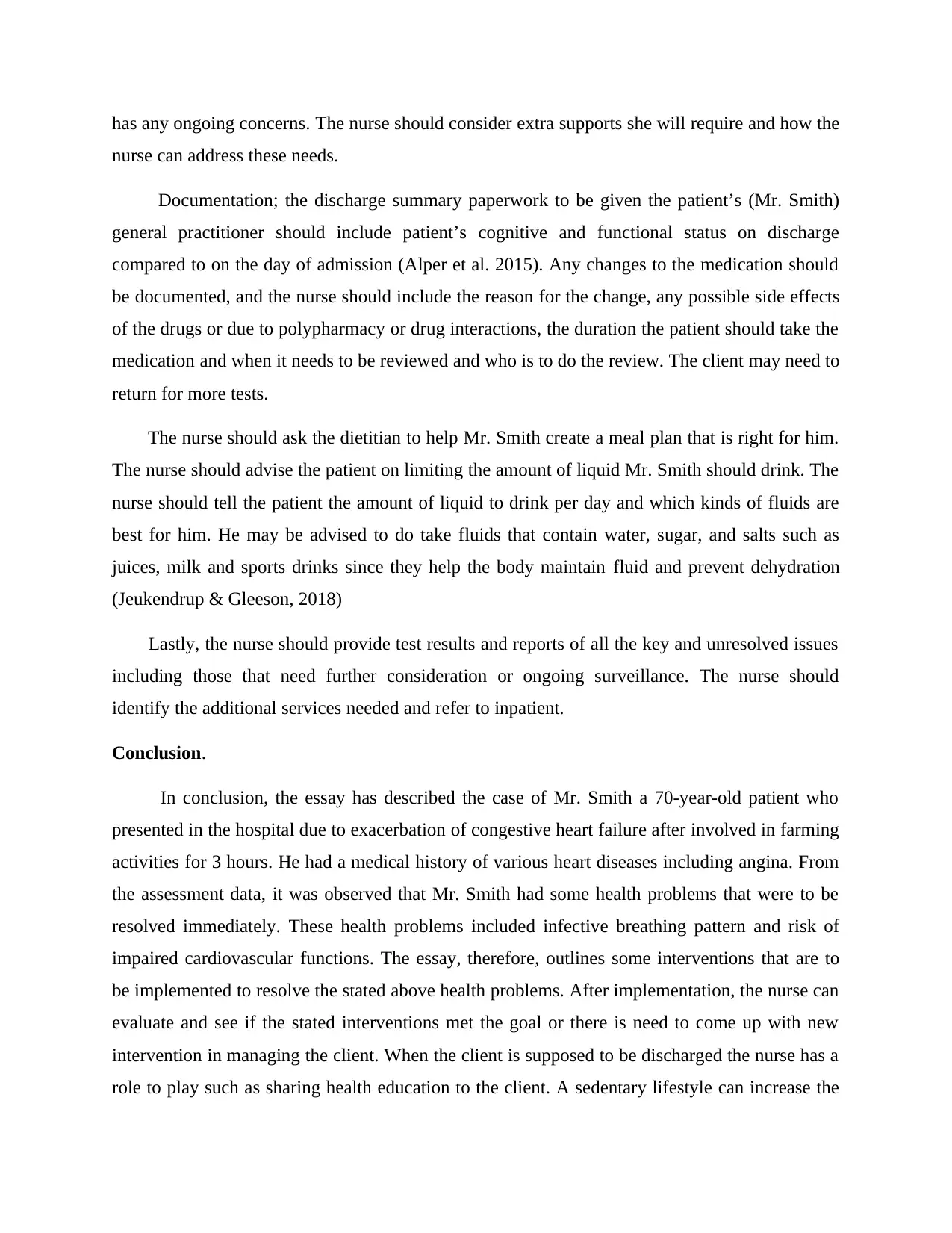
has any ongoing concerns. The nurse should consider extra supports she will require and how the
nurse can address these needs.
Documentation; the discharge summary paperwork to be given the patient’s (Mr. Smith)
general practitioner should include patient’s cognitive and functional status on discharge
compared to on the day of admission (Alper et al. 2015). Any changes to the medication should
be documented, and the nurse should include the reason for the change, any possible side effects
of the drugs or due to polypharmacy or drug interactions, the duration the patient should take the
medication and when it needs to be reviewed and who is to do the review. The client may need to
return for more tests.
The nurse should ask the dietitian to help Mr. Smith create a meal plan that is right for him.
The nurse should advise the patient on limiting the amount of liquid Mr. Smith should drink. The
nurse should tell the patient the amount of liquid to drink per day and which kinds of fluids are
best for him. He may be advised to do take fluids that contain water, sugar, and salts such as
juices, milk and sports drinks since they help the body maintain fluid and prevent dehydration
(Jeukendrup & Gleeson, 2018)
Lastly, the nurse should provide test results and reports of all the key and unresolved issues
including those that need further consideration or ongoing surveillance. The nurse should
identify the additional services needed and refer to inpatient.
Conclusion.
In conclusion, the essay has described the case of Mr. Smith a 70-year-old patient who
presented in the hospital due to exacerbation of congestive heart failure after involved in farming
activities for 3 hours. He had a medical history of various heart diseases including angina. From
the assessment data, it was observed that Mr. Smith had some health problems that were to be
resolved immediately. These health problems included infective breathing pattern and risk of
impaired cardiovascular functions. The essay, therefore, outlines some interventions that are to
be implemented to resolve the stated above health problems. After implementation, the nurse can
evaluate and see if the stated interventions met the goal or there is need to come up with new
intervention in managing the client. When the client is supposed to be discharged the nurse has a
role to play such as sharing health education to the client. A sedentary lifestyle can increase the
nurse can address these needs.
Documentation; the discharge summary paperwork to be given the patient’s (Mr. Smith)
general practitioner should include patient’s cognitive and functional status on discharge
compared to on the day of admission (Alper et al. 2015). Any changes to the medication should
be documented, and the nurse should include the reason for the change, any possible side effects
of the drugs or due to polypharmacy or drug interactions, the duration the patient should take the
medication and when it needs to be reviewed and who is to do the review. The client may need to
return for more tests.
The nurse should ask the dietitian to help Mr. Smith create a meal plan that is right for him.
The nurse should advise the patient on limiting the amount of liquid Mr. Smith should drink. The
nurse should tell the patient the amount of liquid to drink per day and which kinds of fluids are
best for him. He may be advised to do take fluids that contain water, sugar, and salts such as
juices, milk and sports drinks since they help the body maintain fluid and prevent dehydration
(Jeukendrup & Gleeson, 2018)
Lastly, the nurse should provide test results and reports of all the key and unresolved issues
including those that need further consideration or ongoing surveillance. The nurse should
identify the additional services needed and refer to inpatient.
Conclusion.
In conclusion, the essay has described the case of Mr. Smith a 70-year-old patient who
presented in the hospital due to exacerbation of congestive heart failure after involved in farming
activities for 3 hours. He had a medical history of various heart diseases including angina. From
the assessment data, it was observed that Mr. Smith had some health problems that were to be
resolved immediately. These health problems included infective breathing pattern and risk of
impaired cardiovascular functions. The essay, therefore, outlines some interventions that are to
be implemented to resolve the stated above health problems. After implementation, the nurse can
evaluate and see if the stated interventions met the goal or there is need to come up with new
intervention in managing the client. When the client is supposed to be discharged the nurse has a
role to play such as sharing health education to the client. A sedentary lifestyle can increase the
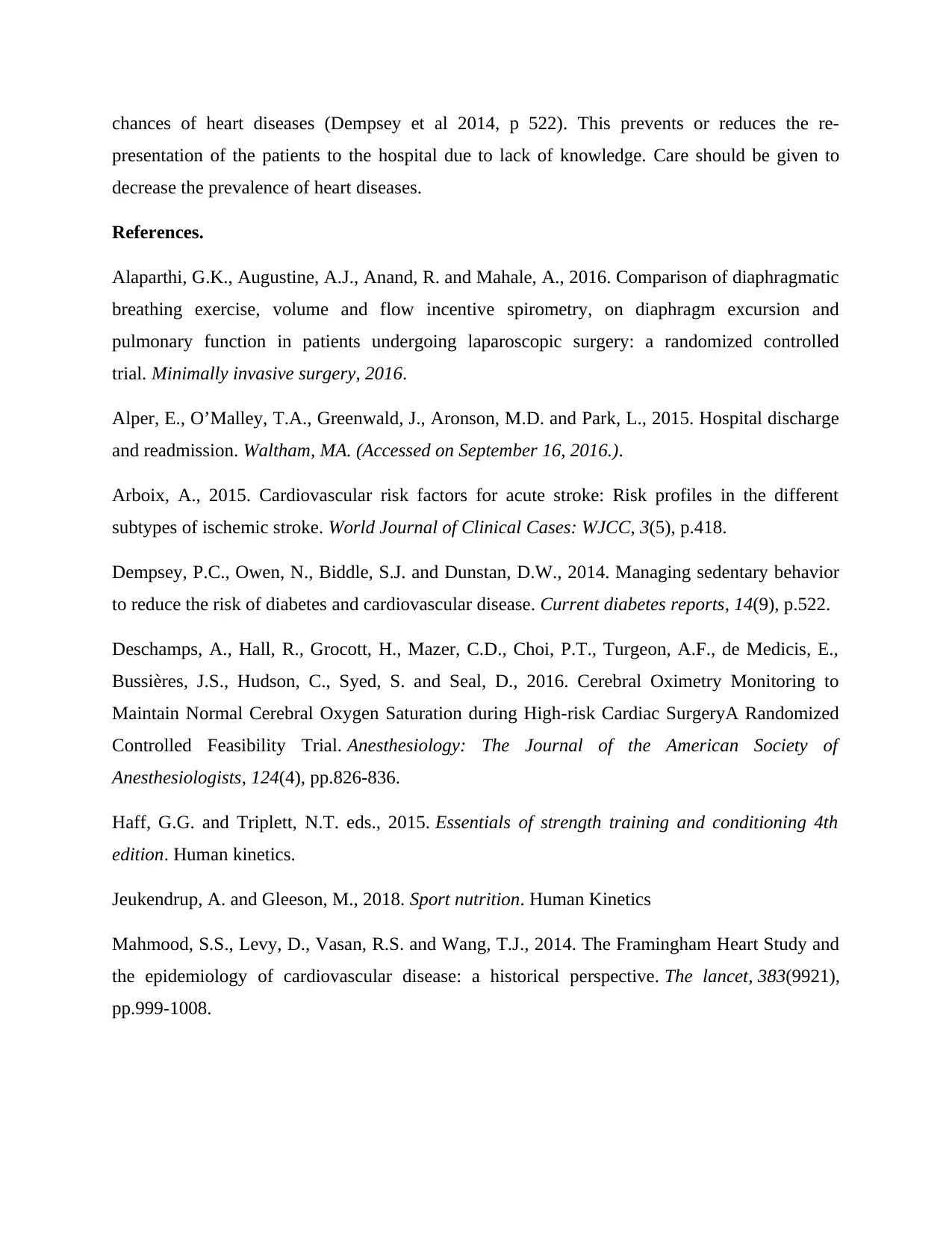
chances of heart diseases (Dempsey et al 2014, p 522). This prevents or reduces the re-
presentation of the patients to the hospital due to lack of knowledge. Care should be given to
decrease the prevalence of heart diseases.
References.
Alaparthi, G.K., Augustine, A.J., Anand, R. and Mahale, A., 2016. Comparison of diaphragmatic
breathing exercise, volume and flow incentive spirometry, on diaphragm excursion and
pulmonary function in patients undergoing laparoscopic surgery: a randomized controlled
trial. Minimally invasive surgery, 2016.
Alper, E., O’Malley, T.A., Greenwald, J., Aronson, M.D. and Park, L., 2015. Hospital discharge
and readmission. Waltham, MA. (Accessed on September 16, 2016.).
Arboix, A., 2015. Cardiovascular risk factors for acute stroke: Risk profiles in the different
subtypes of ischemic stroke. World Journal of Clinical Cases: WJCC, 3(5), p.418.
Dempsey, P.C., Owen, N., Biddle, S.J. and Dunstan, D.W., 2014. Managing sedentary behavior
to reduce the risk of diabetes and cardiovascular disease. Current diabetes reports, 14(9), p.522.
Deschamps, A., Hall, R., Grocott, H., Mazer, C.D., Choi, P.T., Turgeon, A.F., de Medicis, E.,
Bussières, J.S., Hudson, C., Syed, S. and Seal, D., 2016. Cerebral Oximetry Monitoring to
Maintain Normal Cerebral Oxygen Saturation during High-risk Cardiac SurgeryA Randomized
Controlled Feasibility Trial. Anesthesiology: The Journal of the American Society of
Anesthesiologists, 124(4), pp.826-836.
Haff, G.G. and Triplett, N.T. eds., 2015. Essentials of strength training and conditioning 4th
edition. Human kinetics.
Jeukendrup, A. and Gleeson, M., 2018. Sport nutrition. Human Kinetics
Mahmood, S.S., Levy, D., Vasan, R.S. and Wang, T.J., 2014. The Framingham Heart Study and
the epidemiology of cardiovascular disease: a historical perspective. The lancet, 383(9921),
pp.999-1008.
presentation of the patients to the hospital due to lack of knowledge. Care should be given to
decrease the prevalence of heart diseases.
References.
Alaparthi, G.K., Augustine, A.J., Anand, R. and Mahale, A., 2016. Comparison of diaphragmatic
breathing exercise, volume and flow incentive spirometry, on diaphragm excursion and
pulmonary function in patients undergoing laparoscopic surgery: a randomized controlled
trial. Minimally invasive surgery, 2016.
Alper, E., O’Malley, T.A., Greenwald, J., Aronson, M.D. and Park, L., 2015. Hospital discharge
and readmission. Waltham, MA. (Accessed on September 16, 2016.).
Arboix, A., 2015. Cardiovascular risk factors for acute stroke: Risk profiles in the different
subtypes of ischemic stroke. World Journal of Clinical Cases: WJCC, 3(5), p.418.
Dempsey, P.C., Owen, N., Biddle, S.J. and Dunstan, D.W., 2014. Managing sedentary behavior
to reduce the risk of diabetes and cardiovascular disease. Current diabetes reports, 14(9), p.522.
Deschamps, A., Hall, R., Grocott, H., Mazer, C.D., Choi, P.T., Turgeon, A.F., de Medicis, E.,
Bussières, J.S., Hudson, C., Syed, S. and Seal, D., 2016. Cerebral Oximetry Monitoring to
Maintain Normal Cerebral Oxygen Saturation during High-risk Cardiac SurgeryA Randomized
Controlled Feasibility Trial. Anesthesiology: The Journal of the American Society of
Anesthesiologists, 124(4), pp.826-836.
Haff, G.G. and Triplett, N.T. eds., 2015. Essentials of strength training and conditioning 4th
edition. Human kinetics.
Jeukendrup, A. and Gleeson, M., 2018. Sport nutrition. Human Kinetics
Mahmood, S.S., Levy, D., Vasan, R.S. and Wang, T.J., 2014. The Framingham Heart Study and
the epidemiology of cardiovascular disease: a historical perspective. The lancet, 383(9921),
pp.999-1008.
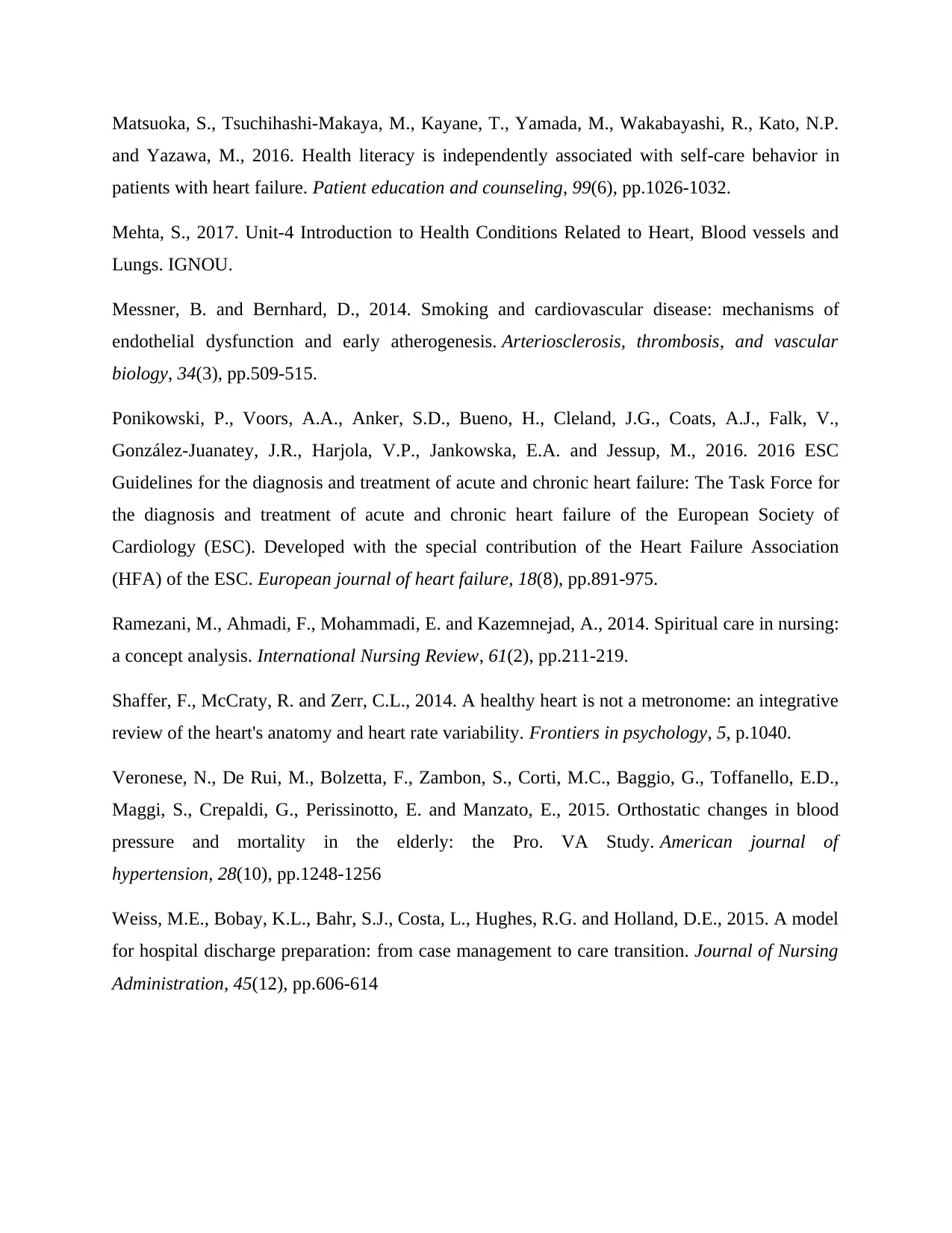
Matsuoka, S., Tsuchihashi-Makaya, M., Kayane, T., Yamada, M., Wakabayashi, R., Kato, N.P.
and Yazawa, M., 2016. Health literacy is independently associated with self-care behavior in
patients with heart failure. Patient education and counseling, 99(6), pp.1026-1032.
Mehta, S., 2017. Unit-4 Introduction to Health Conditions Related to Heart, Blood vessels and
Lungs. IGNOU.
Messner, B. and Bernhard, D., 2014. Smoking and cardiovascular disease: mechanisms of
endothelial dysfunction and early atherogenesis. Arteriosclerosis, thrombosis, and vascular
biology, 34(3), pp.509-515.
Ponikowski, P., Voors, A.A., Anker, S.D., Bueno, H., Cleland, J.G., Coats, A.J., Falk, V.,
González‐Juanatey, J.R., Harjola, V.P., Jankowska, E.A. and Jessup, M., 2016. 2016 ESC
Guidelines for the diagnosis and treatment of acute and chronic heart failure: The Task Force for
the diagnosis and treatment of acute and chronic heart failure of the European Society of
Cardiology (ESC). Developed with the special contribution of the Heart Failure Association
(HFA) of the ESC. European journal of heart failure, 18(8), pp.891-975.
Ramezani, M., Ahmadi, F., Mohammadi, E. and Kazemnejad, A., 2014. Spiritual care in nursing:
a concept analysis. International Nursing Review, 61(2), pp.211-219.
Shaffer, F., McCraty, R. and Zerr, C.L., 2014. A healthy heart is not a metronome: an integrative
review of the heart's anatomy and heart rate variability. Frontiers in psychology, 5, p.1040.
Veronese, N., De Rui, M., Bolzetta, F., Zambon, S., Corti, M.C., Baggio, G., Toffanello, E.D.,
Maggi, S., Crepaldi, G., Perissinotto, E. and Manzato, E., 2015. Orthostatic changes in blood
pressure and mortality in the elderly: the Pro. VA Study. American journal of
hypertension, 28(10), pp.1248-1256
Weiss, M.E., Bobay, K.L., Bahr, S.J., Costa, L., Hughes, R.G. and Holland, D.E., 2015. A model
for hospital discharge preparation: from case management to care transition. Journal of Nursing
Administration, 45(12), pp.606-614
and Yazawa, M., 2016. Health literacy is independently associated with self-care behavior in
patients with heart failure. Patient education and counseling, 99(6), pp.1026-1032.
Mehta, S., 2017. Unit-4 Introduction to Health Conditions Related to Heart, Blood vessels and
Lungs. IGNOU.
Messner, B. and Bernhard, D., 2014. Smoking and cardiovascular disease: mechanisms of
endothelial dysfunction and early atherogenesis. Arteriosclerosis, thrombosis, and vascular
biology, 34(3), pp.509-515.
Ponikowski, P., Voors, A.A., Anker, S.D., Bueno, H., Cleland, J.G., Coats, A.J., Falk, V.,
González‐Juanatey, J.R., Harjola, V.P., Jankowska, E.A. and Jessup, M., 2016. 2016 ESC
Guidelines for the diagnosis and treatment of acute and chronic heart failure: The Task Force for
the diagnosis and treatment of acute and chronic heart failure of the European Society of
Cardiology (ESC). Developed with the special contribution of the Heart Failure Association
(HFA) of the ESC. European journal of heart failure, 18(8), pp.891-975.
Ramezani, M., Ahmadi, F., Mohammadi, E. and Kazemnejad, A., 2014. Spiritual care in nursing:
a concept analysis. International Nursing Review, 61(2), pp.211-219.
Shaffer, F., McCraty, R. and Zerr, C.L., 2014. A healthy heart is not a metronome: an integrative
review of the heart's anatomy and heart rate variability. Frontiers in psychology, 5, p.1040.
Veronese, N., De Rui, M., Bolzetta, F., Zambon, S., Corti, M.C., Baggio, G., Toffanello, E.D.,
Maggi, S., Crepaldi, G., Perissinotto, E. and Manzato, E., 2015. Orthostatic changes in blood
pressure and mortality in the elderly: the Pro. VA Study. American journal of
hypertension, 28(10), pp.1248-1256
Weiss, M.E., Bobay, K.L., Bahr, S.J., Costa, L., Hughes, R.G. and Holland, D.E., 2015. A model
for hospital discharge preparation: from case management to care transition. Journal of Nursing
Administration, 45(12), pp.606-614
1 out of 7
Related Documents
Your All-in-One AI-Powered Toolkit for Academic Success.
+13062052269
info@desklib.com
Available 24*7 on WhatsApp / Email
![[object Object]](/_next/static/media/star-bottom.7253800d.svg)
Unlock your academic potential
© 2024 | Zucol Services PVT LTD | All rights reserved.





